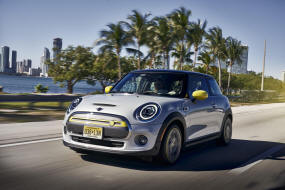 Mini Cooper
Mini Cooper
 |
About Mini (Cooper)
|
The year was 1957, and in post-World War II England the Suez Crisis had sent fuel prices soaring, leading many to start wondering if the large, gas-guzzling vehicles of the day made much sense. So Sir Leonard Lord of the Morris Company issued his top engineer, Alec Issigonis, a challenge: design and build a small, fuel-efficient car capable of carrying four adults, within economic reach of just about everyone. As fate would have it, the challenge of fitting so much function into such a small package inspired a couple of historic innovations. The two most important innovations Issigonis came up with were to create more room in the cockpit: pushing the wheels all the way out to the corners and turning the engine sideways giving the car more stability in tight turn and more passenger space on the inside. The world had never seen a car quite like it. And when the first Mini launched in 1959, the public was a bit baffled. Soon enough, people began to recognize that the Mini was not merely a car. The unique combination of classic British style in a low-cost, small size, fun and nimble package came to symbolize independence and spontaneity. The very essence of the youthful 1960s culture. One of the most remarkable elements of the Classic Mini’s popularity was how its infectious spirit transcended traditional class barriers. From hipsters and mods to milkmen, rock stars and royalty to rally racers. Everyone could have efficiency, fun and freedom, motoring in a Mini. It soon became apparent that, while intended to create more passenger room, Issigonis’s numerous layout innovations also helped make the Mini a standout performance car. Wheels at the corners meant a wide, go-kart stance and nimble handling. And the transverse engine kept weight over the front tires, helping provide great balance and grip. It was 1961 when the humble little people-mover fell into the hands of British racing legend John Cooper. A more powerful engine, bigger brakes and a few tuning tweaks later, the Classic Mini Cooper 997 was introduced. And a rally demon was born. Before long, the nimble little Classic Mini was outracing and outlasting the larger, more powerful, but clumsier sedans of the day. Visits to the winner’s circle became a regular event as Mini chalked up numerous international race wins – including 3 at the prestigious Monte Carlo rally from 1964 to 1967. In addition to being exhilarating to drive, owners loved how easily their Mini became an extension of themselves. A dynamic expression of their individuality and a personality-packed sidekick that was always up for a bit of spontaneous fun. By 1969, over 2 million Mini had been sold around the world. Pickup and station wagon versions were introduced and all were incredibly durable – whether rallying or doing the daily errands. Owners knew they could depend on their Mini to get the job done. And inspire smiles the entire time. By 1977, the Classic Mini’s popularity had truly taken off around the world with over 4 million cars sold in each corner of the globe. Sadly, Americans never quite got the chance to catch the fever since new emissions regulations in the late 1960s forced Mini to give up its U.S. green card. Fast forward to 1999. Over 5 million Classic Minis had found happy homes around the world leading a panel of 130 international automotive journalists to vote Mini “European Car of the Century.” In fact, only Ford’s Model T received more votes for the global title. In October of 1999, just a few days before the final Classic Mini rolled off the production line, the concept for a new MINI is unveiled at the Paris Auto Show. The distinctive design and personality is immediately recognizable. But it’s clear that the new model has also taken a healthy dose of automotive steroids. Taking the 2003 North American Car of the Year Award, the general public and auto enthusiasts alike find the new MINI hard to resist. Invoking smiles and curiosity everywhere they go, new owners quickly discover just how much fun a MINI can be. Owners personalize their MINIs to their hearts’ content and form motoring clubs all across the country. Like their notorious predecessors, all new MINI models share the same great performance DNA. Updated with modern performance features and a committed passion for racing, the MINI Motorsport teams are once again taking tracks (or, in the case of the World Rally Championship and Dakar Challenge, dirt roads and deserts) by storm. The newest to represent our racing heritage is the MINI John Cooper Works Team, who wield a pair of the most powerful MINI models ever built – the John Cooper Works Hardtop 2 Door. Since the Hardtop burst onto US roadways in 2002, the public’s appetite for MINI has grown along with the MINI lineup. The expanding family includes available ALL4 all-wheel drive, three models with more seating and four doors, spirited two-seaters, topless motoring – and a new era of sophisticated technology and high-end interiors. Around the world, the MINI phenomenon has been reborn. Proof that great fuel efficiency, an almost limitless range of customization, incredibly tight handling and an undeniably cheeky personality are truly timeless qualities. Most recently, we've added the spacious and sophisticated MINI Clubman, and the powerful John Cooper Works Hardtop 2 Door – proving that there are still more boundaries to push and horizons to chase. With beta programs and partnerships like the 100% electric, zero-emissions MINI E, we're excited to find out what adventures are in store for the next 60 years. |
